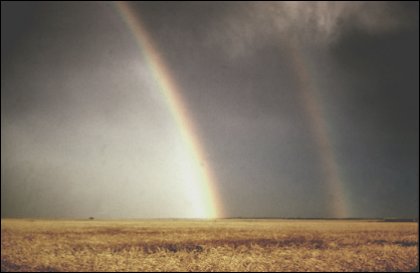

Rainbows bring smiles and dreams of pots of gold. If you want to chase a rainbow, go out on a showery day when the sun is low, and turn so that the sun is at your back. If you could measure it, you'd find the angle from where the light strikes the raindrops to where you see a rainbow is about 41°. As white light, which is composed of many different colors, passes through the raindrop prisms, it is bent, and the colors are separated into a precise order: red, orange, yellow, green, blue, indigo, and violet. Back in 1667, it was the English scientist and mathematician, Sir Isaac Newton, who analyzed this composite nature of light.
Sometimes we see two rainbows because the light is reflected through the raindrops twice. The colors in this secondary rainbow are reversed from those in the primary rainbow. This reflected light 'bow accompanies many rainbows but is usually too faint to see.
When rains come to our Chihuahuan Desert with its big skies, we are
often in just the right place to catch a rainbow! Finding a pot of gold will have to
wait for another day!

Listen to the Audio (mp3 format) as recorded by KTEP, Public Radio for the Southwest.
Contributor: Scott Cutler, Centennial Museum, University of Texas at El Paso.
Desert Diary is a joint production of the Centennial Museum and KTEP Public Radio at the University of Texas at El Paso.

A primary and a secondary rainbow near Altus, Oklahoma, May 29, 1975. Photograph courtesy of NOAA Photo Library, NOAA Central Library; OAR/ERL/National Severe Storms Laboratory (NSSL).
Ahrens, C. D. c1991. Meteorology today : an introduction to weather, climate, and the environment . West Pub. Co., St. Paul.
Bohren, Craig F. c1987. Clouds in a glass of beer : simple experiments in atmospheric physics. Wiley, New York.
Boyer, C. B. 1959. The Rainbow From Myth to Mathematics. Princeton University Press, Princeton.
Fraser, Aa. B. 1972. Inhomogenieties in the Color and Intensity of the Rainbow. Journal Atmospheric Sciences, 29:211.
Greenler, R. 1980. Rainbows, Halos, and Glories. Cambridge University Press, Cambridge.
Humphreys, W. J. 1929. Physics of the Air. McGraw-Hill Book Co.
Humphreys, W. J. 1923. Weather: Proverbs and Paradoxes. Williams and Wilkins Co.
Johnson, J. C. 1954. Physical Meteorology, MIT Press, LCC 54-7836.
Lynch, D. K., and W. Livingston. 1995. Color and Light in Nature. Cambridge University Press, Cambridge.
Lynch, D. K., and P. Schwartz. 1991. Rainbows and Fogbows. Applied Optics, 30:3415.
Magie, W.F., ed. 1935. A Source Book in Physics.
Minnaeart, M. 1954. The Nature of Light and Color in the Open Air, Dover.
Nussenzveig, H. Moyses, "The Theory of the Rainbow", Scientific American 236, 116, 1977
Planz, Brian, 1995 Rainbows
Pruppacher, H. R. and Beard, K. V., 1970, Quart. J. Royal Meteor. Soc. 96, 247
Pruppacher, H. R. and Klett, J. D. 1978, Microphysics of Clouds and Precipitation, Reidel Publishing Company
Pruppacher, H. R., and R. L. Pitter. 1971. Atmospheric Science, 28:86.
Science Universe Series (D. Jollands, ed.). 1984. Sight, Light, and Color. Arco Publishing Inc., ISBN 0-668-06177-4.
van Beeck, J.P.A.J. 1997. Rainbow Phenomena: development of a
laser-based, non-intrusive technique for measuring droplet size, temperature, and
velocity. CIP-Data Library Technische Universiteit Eindhoven, ISBN 90-386-0557-9.
![]()